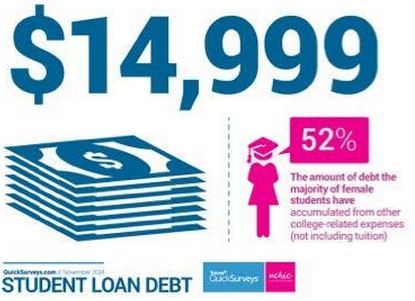
Alexis Grippi, of Collegeville, Pa., longs for the day she can open up her own fashion boutique. Unlike other students competing to gain a foothold in the fashion industry, Alexis has not been able to pursue the highly coveted college internships (often unpaid) needed to give her a leg up. She graduates this spring from Pennsylvania's Immaculata University with an overall debt of $52,000. Funding for anything beyond tuition and room and board has been out of the question.
Alexis is not the only young woman facing a more competitive job market these days. As part of our "State of the Girls Series", we have found, in partnership with Toluna QuickSurveys.com, that when female college students borrow more to pursue key career-building experiences, they add up to almost $15,000 more to their debt upon graduation, a good 52 percent of their overall college debt load. The problem with this number? The borrowing cost to access these opportunities is often greater than the principle amount borrowed, making these opportunities more expensive overall to students.
This burden has left the U.S. female graduate with over $28,000 in student loan debt, according to The Institute for College Data and Statistics. Moreover, a new report from the Brookings Institution points out that this student debt average is quadruple the amount that it was just 12 years ago.
At the same time, the entry-level job scene is ever more competitive today as students increasingly are gaining real world work experiences while at school, whether on campus or through the now ubiquitous internship. Other extracurricular activities are also more competitive, as students use those internships to create strong social networks than can be helpful post-graduation. And the truth, due to lack of extra funds available, not every student can access those activities that can be key to finding a job post-graduation. This gap leaves the playing field uneven when it comes to equal access to opportunities for U.S. college students.
For graduating women, these challenges can be exacerbated further with the gender wage gap that only increases over the span of a woman's career.
What's a Girl to Do?
Well, that's obviously the not-so-great news. Fortunately, for those looking to subsidize those much needed internships or extracurricular activities, you have options. A quick look online reveals all types of scholarship opportunities, even the wild and wacky--crochet or knit? There's a scholarship for you!
The biggest hurdle? It's often where to start looking for such opportunities. Once you choose a school, look for scholarship and grant opportunities starting in your own backyard, such as your school's Parent Teacher Association (high school students) or alumni association (college students). For scholarships that help fund expenses beyond tuition - like study abroad or a coveted internship - our 1,000 Dreams Fund is a good one to consider when looking to cover extra expenses that can help keep down the total amount you borrow.
One of the best sources of information you can rely on is the college or university you are planning to attend. Your school's financial aid office has people trained to answer any and all questions you may have. Universities are just as invested in helping you responsibly fund your college experience as you are.
When following your dreams and pursuing those life-changing opportunities, please keep in mind that there are funding options available and they don't all require straight A's. Many students think they aren't qualified or give up too soon, leaving that valuable scholarship money on the table. In federal grant money alone, college students left $2.9 billion on the table during the 2013-2014 academic year, according to NerdScholar.
Don't let that be you!


